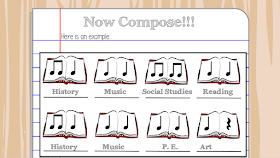To start the year, I plan a unit that will review many musical elements and dust off the vocabulary they may have forgotten over summer. This is a 3-lesson unit for 4th grade which will get the students playing rhythms, singing a melody, playing harmony, improvising, and composing. Here is an overview:
Lesson 1:
Lesson 2:
The Remix!!! We review the poem and discuss the musical elements. We discover we were missing melody and harmony in our previous lesson. We echo solfege and review the lines and spaces on the staff. We perform the melody on Orff instruments. We add a broken bordun for harmony. I have the students echo a rhythmic phrase "Fourth Grade Rocks!" They improvise with that phrase twice. I give them parameters for their improvisation. The first phrase CANNOT end on do (C). The second phrase HAS to end on do (C). We perform the improvisations in small groups: 1) glockenspiels; 2) alto/soprano xylophones; 3) metallophones, 4) basses. Our final performance is ABA form with the improv sandwiched between the song.
Lesson 3:
We compose! The students match school subjects with the correct rhythmic building block. I ask them to create a phrase using 8 books. I give them some parameters for composing. I ask that the last book be a rhythm with quarter note and quarter rest. I also ask that the phrases begin with the same 2 books. (Books 1 and 5 should be identical and books 2 and 6 should be identical). The students first get in small groups and use manipulatives to compose. Using manipulatives first saves the erasers on my pencils!!! When the group can perform the poem both verbally and with body percussion, they are given a worksheet to notate their patterns. When everyone is finished with their worksheet, we do a final performance in rondo form sharing the book compositions. We alternate the "Welcome back, Class" poem with each individual group.
This unit is always great fun! After only 3 lessons, I can say my students have used body percussion, played drums, played xylophones, used expressive speech, used their singing voice, performed in round, with ABA form, and rondo form, improvised melodically, and composed rhythms! It is a great way to start the year!
If you are interested in teaching this unit, you can search my TpT store for full lesson plans, PowerPoints, printable worksheets, and manipulatives.














